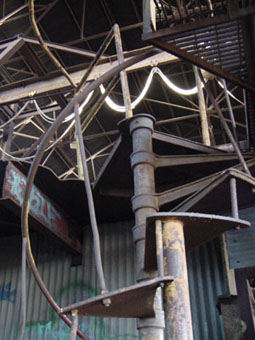(continued from here)
Architecturally the uncanny disorientates, pushes us into an ambiguous landscape of shock and convulsion, but simultaneously enforces a sense of aesthetic pleasure at the cost of emotional displacement. The dissident presence of the ‘opposite’ then, is what renders the uncanny either enticing or abhorrent according to ones aesthetic judgment. Faced with a building that no longer serves its function, and as such has been reduced to an abandoned space, then what is immediately evident is the presence of an underlining presence that seems to undermine any former aspiration to utilitarian worth: – decay feeds upon such aspirations, clawing at the machines that covet production and consumption. Here the opposite has emerged converting a space of usefulness to a space of uselessness. Relating the space of dereliction to its role as a pernicious space of negation amongst the ‘civility’ of everyday life, then we can perhaps assume that it is the presence of the uncanny opposite that subverts the otherwise regulated locus of urban life. Conservatives, restorers, and curators wince at the sight of dereliction, considering its decay a deformation of the original spirit. Clung to the rungs of utilitarianism, then such a pre-occupation with function and use excludes the aesthetic merits with which dereliction offers. And yet it is such a direct conversion of usefulness to uselessness that is vital to the derelict’s appeal.
Often we find the space of dereliction haunted and bemused by a potent array of memories. Untangled, they remain buried beneath obscurity or debris. Removing shards of burnt steel and fallen pillars we find traces of an existence that is no longer. All that remains is the trace of a lost presence. How easy then, it is to be enticed by reveries of absent spirits who no longer roam abandoned corridors in the brink of daylight. In the waste of post-industrial dereliction this episodic burst of spectral haunting is undoubtedly both enthralling and enhanced. Machines that no longer fulfil their former function, and as such have become beacons of decay, are central to this dynamic. Of course, the machine is synonymous with utility and so when we encounter a defunct mechanism then we are both enticed and bewildered. Students of Marcel Duchamp’s ‘ready-mades’ who seek the hidden meaning in the useless fail to identify the simple beauty of an object that no longer serves any use. Likewise, in the space of dereliction it is the orgy of obsolescence that is so striking. Removed from its context then we have been transposed to a landscape comprised from dislocated artefacts whose only merits are their aesthetic pleasure. Anyone who has explored an abandoned factory knows well how machines, objects, and tools can adopt an uncanny form. Control panels whose buttons no longer whirl machines into action, impotent and dormant in a sanctuary of inertia, the sheath of rust that now animates the movement of these discarded buttons their only song. Peering into splintered glass reveals a wall of cogs glimmering through the dust, their rotating wheels arrested in empty space; we may retort against a cloud of asbestos, but from the vantage point of contemplation it is wholly apparent that in the derelict only the poetry of absence resides. In the abandoned factory, the diffusion of absence is such to be brought to life through the presence of a tangible loss framed by the memory of a function that no longer resides. Those momentous creature of industrial culture, too heavy to be removed, to dangerous to be demolished, left abandoned by their erstwhile owners, though dormant they nevertheless seethe with the pulse of vacuous exhaustion.
Even if the conversion of the useful to the useless is only partial, then in the factory there emerges a vivid distortion of original function – objects that were once primed for action have now been reclaimed by flora and fauna thus producing a novel fusion between the synthetic and the organic. How shall we account for the static conveyer belt now being used as a nest for exiled pigeons? Suddenly – as though be revelation – prosaic objects take on a divine guise: what was once regarded as dogmatically pragmatic is now a furrow through which a stream of cloudy water runs; windows that were once used to reflect the light convert themselves into viewing galleries through which the emanation of the uncanny can expand. But such things are not limited to visual stimuli, since smells too have the effect of inducing a heady musk of pleasure. In the factory the severance of objects from their original context is accompanied by the distinct odour that they leave behind. Who can fail to be aroused by the faint trace of crumbling masonry or the distinct vestige of absent ammonia? The experience is heightened by the sense of disembodiment that the blend of disparate smells induce. When the pre-Socratic Anaxagoras therefore writes that “appearances…are a glimpse of the obscure,”3 we know that his nose may have betrayed his eyes. So too does the explorer of the derelict seek to unearth an olfactive allusion that only gives rise to a hiatus of space. The smells that linger long after their actual objects have departed collude us into a state of disembodiment and disorientation. Haunted therefore, is the trompe l’oeil that gives rise to an apparition that is experienced but not seen.
In compounding the past with the present and the present with the absent, the uncanny dismantles our linear understanding of space and time, and as such provides a platform on which we are able to penetrate the veil of appearances. Dereliction hence clarifies our senses by perplexing them, permits a glimpse into the obscurity of space by affirming its impalpable nature. As voyeurs of the useless, it is the space of bewilderment that is most enticing. What draws to spaces of dereliction if not this sublime alchemical disjunction between usefulness and uselessness, if not the exquisite pleasure that is the uncanny conjunction between the presence and absence?
Endnotes:
1 Freud, S. The Uncanny in Art and Literature Ed: Dickson, A (Penguin, 1985)
Page 364
2 Bloch, E. Building in Empty Spaces in The Utopian Function of Art and Literature:
Selected Essays Trans: Zipes, J. & Meckelburg, F. (MIT Press, 1988) Page
186
3 Anaxagoras The Pre-Socratic Philosophers, Trans. & Ed. Kirk, Raven and
Schofield. (Cambridge, 1987)
Dylan Trigg is a writer of decay, dissolution, and ruination, principally
concerned with themes of silence, exile, voyeurism, mourning, decline, the
aesthetics of absence, the phenomenology of home, and the exhaustion of reason.
He is contributing to Crosswalk from the United Kingdom. Read more of his
writings at www.geocities.com/dylan_trigg.

